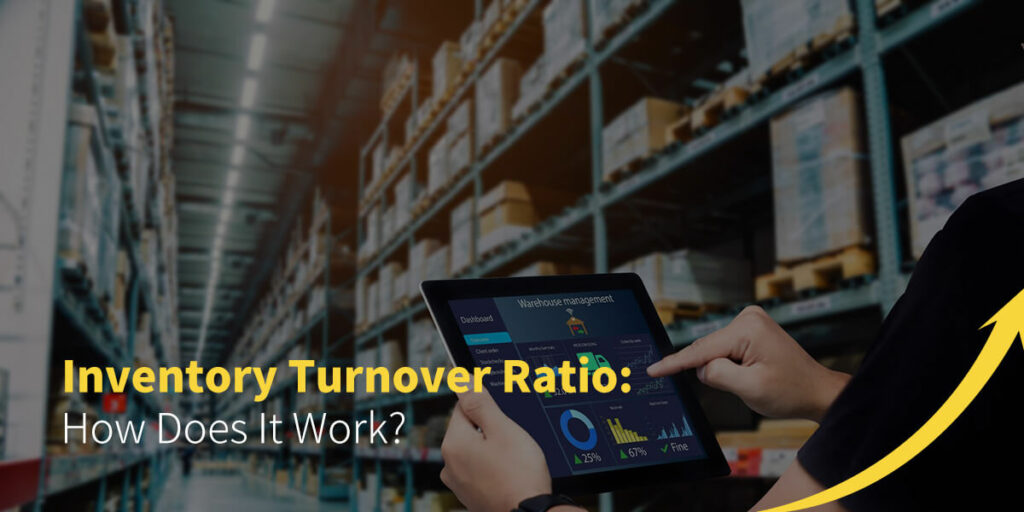Inventory turnover broadly refers to how often a company changes its inventory, either by sales or replacement. Thus, the turnover ratio indicates how many times you acquire new inventory in a given period.
The inventory turnover ratio is an essential metric for making business decisions. This post will help you understand how it works
Table of Contents
- How to calculate inventory turnover ratio?
- Which is the best Inventory Turnover Ratio?
- Why should you calculate the inventory turnover ratio?
- Limitations to using Inventory turnover ratio to make business decisions
- How to optimize inventory turnover for better ratios

How to calculate inventory turnover ratio
There are 2 main methods of calculating the inventory turnover ratio.
Method 1
Dividing the Cost of goods sold over the average inventory.
Inventory turnover ratio= Cost of goods sold ÷ Average inventory
How does this work?
This ratio indicates the relationship between how much you spend purchasing the goods and how often you do so.
The Cost of Goods sold (COGS) is the Cost of sales you make in a given period. You can calculate it by:
COGS= Beginning Inventory + Net Inventory Purchases – Ending inventory
Average inventory is how much inventory is present in the business at every point in time. An average is necessary because inventory fluctuates overtime. You can calculate it by:
Average inventory = (Beginning Inventory + Ending inventory) ÷ 2
To find the number of days it takes you to sell your goods, consider the time frame you are targeting. For instance, if you do it yearly, it’s 365 days. So, your formula for a turnover period will be:
Turnover period= 365 ÷ Inventory turnover ratio
Method 2
The second method is the sales and ending inventory method. Here, you use the formula:
Inventory turnover ratio= Sales ÷ Ending inventory
This method offers a more general view of the turnover. It is less detailed and less accurate than the first method and includes factors like markup. To calculate for a specific time frame, account for the time period as well.
Turnover period= 365÷ Inventory turnover ratio
The two methods will also give you different results but are both credible. Your choice depends on which one gives you a better view of your business performance.
Which is the best Inventory Turnover Ratio?
The optimal inventory turnover ratio depends on your line of business and the industry. However, ideally, the higher the turnover ratio, the better.

A low inventory turnover ratio
Depending on your business category, a low inventory turnover ratio is often bad for business. It means that goods are not selling. So, you are spending money on goods and not getting returns.
Unsold inventory yields extra costs. For example,
- Storage costs for keeping the unsold inventory
- A lot of money caught up in the unsold goods that you could use for something else.
- The longer products stay in storage, the higher the chances of them becoming obsolete or damaged.
Low inventory turnover ratio is often one of two things:
- You are having sluggish sales, which could be due to poor marketing, the market environment, etc.
- You have too much stock. If you buy in excess, your Cost of sales will be very high, which could give the impression of low turnover.
A high inventory turnover ratio
A high inventory turnover ratio could mean one of two things.
- People are buying your product at a fast rate, which is generally a great thing. The more products people purchase, the sooner you get returns on your investment.
- You are not stocking enough, yet people are buying products at a fast rate. This is not desirable as it is very likely you are losing a lot of money and opportunities.
Therefore, higher rates are only as good as how much profits you make on each sale and how fast you can refill.
If you aren’t making any profits, a high rate may be costing your business more money instead. Similarly, if you do not stock more inventory fast enough, you might be sending customers off to the competition.
Why should you calculate the inventory turnover ratio?
It guides your business purchase decisions.
With this ratio, you will know which items are selling and how fast. This information will then guide you on which items to purchase.
You will also tell which products move more quickly than others and thus need replenishment more often.
You can then derive the appropriate strategies to reduce purchase quantity or sell off slow-moving products.
It helps reduce costs.
Having slow-moving items can be very costly to your business. When goods take long to sell, they occupy more space, thus increasing the storage costs.
Also, a lot of money gets caught up in the inventory and becomes unavailable for other business activities.
With inventory turnover ratio information, you can identify the problem areas. These then help to derive appropriate strategies to reduce these costs.
Limitations to using Inventory turnover ratio to make business decisions
Accounting for other factors
Inventory turnover rate is useful only against a backdrop of other factors. This is because the inventory turnover ratio varies between industries. In some, goods move much faster—for example, grocery stores.
In others, they move slower, for example, in machinery.
Unless you compare your turnover ratios with other firms in your industry, you can’t make a credible analysis.

Limited details
In some cases, the turnover ratio may not help in making specific purchasing decisions. The rate only shows the average inventory sales. It doesn’t show which products made up most of those sales and which did not.
Without such information, it can be hard to know which items you should reduce when purchasing and which one you should buy more of.
How to optimize inventory turnover for better ratios
The best way to improve the turnover ratio is to enhance your inventory management and forecasting processes. To do so, you’ll have to;
- Make periodic sales and promotions. In the case of excess inventory, this method works best. It helps you get rid of old stock even though it brings in less revenue. Also, you can free up space and money for new, more promising inventory.
- Prioritize and optimize inventory. If you sell a variety of products, they will often vary in demand, frequency of purchase, costs, etc. It thus helps to classify your products accordingly and give purchase priority to those that generate the most sales and revenues.
- Hire an inventory management professional. A partner like NextSmartShip can provide you with a data-driven inventory management strategy, whatever your business needs.
